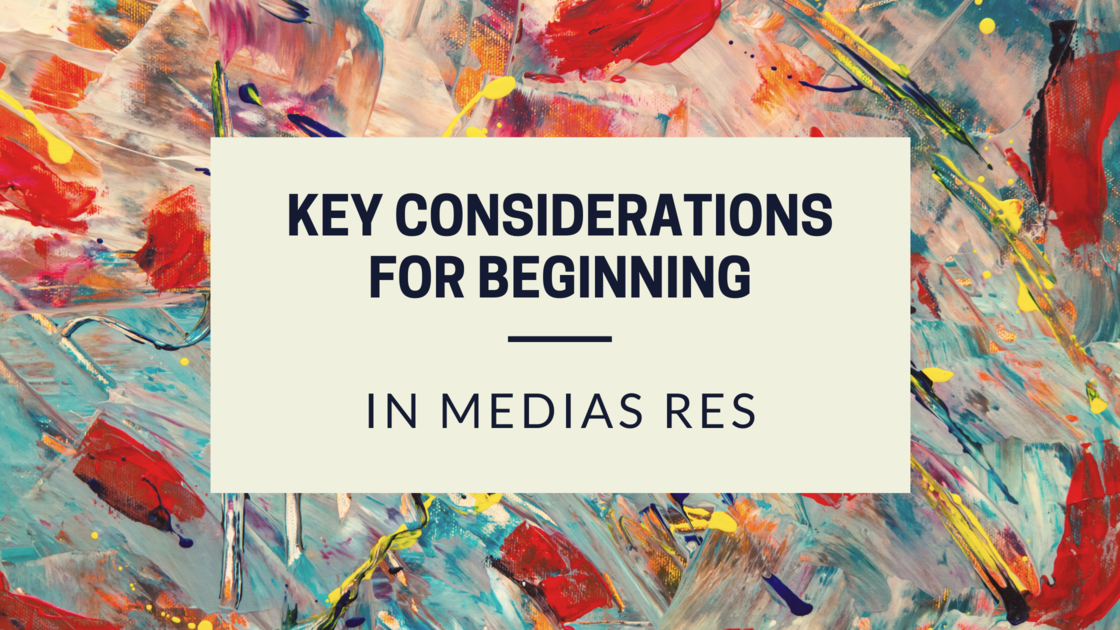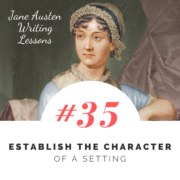#12: Start In Medias Res to Jump Into the Story
I have an unpublished novel that I wrote and revised years ago. It’s a pretty good story, but the beginning never worked. I tried starting it dozens of ways, establishing the exposition this way and that, and ultimately, I set the story aside. Now, as I look back on it, I realize that I was starting the story way too early. If I were to revise it again, I would start it much later, in medias res.
In medias res means, literally, “in the middle of things.” It’s a term originally used by Horace over 2000 years ago in his work Ars Poetica (Poetic Arts).
Basic plot structure demands that a story needs a Beginning, a Middle, and an End. But sometimes, a story does not actually need a Beginning. Or at the very least, it doesn’t need to start at the beginning.
Unlike Jane Austen’s other novels, which begin with paragraphs or chapters of exposition, establishing the characters and the world, in Pride and Prejudice, we begin in medias res. The inciting incident is that Mr. Bingley has joined the community—and this inciting incident occurs before the first page of the book. As we’ve previously discussed, inciting incidents disrupt the world of the characters, shaking them out of stasis and starting them on their journey.
In many cases, we need exposition before we can understand or appreciate how the world has been changed and its characters have been incited into action. Yet there are benefits to jumping straight into the heart of the story.
Benefits of starting a story in medias res:
-It immediately focuses the reader on the main stakes
-There is inherent excitement, energy, and movement in what comes after the inciting incident
-It avoids what could be (in certain stories) slow or unnecessary exposition
-It can create suspense to learn not just what will happen next, but also, what happened before
Chapter 1 of Pride and Prejudice
The first two paragraphs (beginning with the famed “It is a truth universally acknowledged”) are thematic, and provide commentary on society and the characters without providing true exposition. Then, starting with the third paragraph we read:
“My dear Mr. Bennet,” said his lady to him one day, “have you heard that Netherfield Park is let at last?”
Mr. Bennet replied that he had not.
“But it is,” returned she; “for Mrs. Long has just been here, and she told me all about it.”
Mr. Bennet made no answer.
“Do you want to know who has taken it?” cried his wife impatiently.
“You want to tell me, and I have no objection to hearing it.”
That was invitation enough.
We are brought immediately into the action of the novel, as Mrs. Bennet attempts to use all of her powers of persuasion to convince Mr. Bennet to call on Mr. Bingley so their daughters can be introduced to this newly-arrived, eligible bachelor.
Without need for straightforward exposition, we are introduced to things that would commonly be established in a more traditional exposition: the characters’ attributes and the importance to Mrs. Bennet of marrying her daughters.
“What is his name?”
“Bingley.”
“Is he married or single?”
“Oh! Single, my dear, to be sure! A single man of large fortune; four or five thousand a year. What a fine thing for our girls!”
“How so? how can it affect them?”
“My dear Mr. Bennet,” replied his wife, “how can you be so tiresome! You must know that I am thinking of his marrying one of them.”
“Is that his design in settling here?”
“Design! Nonsense, how can you talk so! But it is very likely that he may fall in love with one of them, and therefore you must visit him as soon as he comes.”
If dialogue is used, as it is in this case, to give hints of exposition, it must seem natural that the characters would really say these things. The effectiveness of including these details derives from the fact that Mr. Bennet is attempting to annoy his wife and feign ignorance of her matrimonial plans.
Interestingly, we don’t actually see the main character—Elizabeth—in a scene until Chapter 2. In Persuasion, each of the three sisters is given a thorough introduction by the narrator, and then we meet them and see them in action. In Pride and Prejudice, we are not given a through exposition to establish the characters; we must learn of them on the way. In the first chapter, Mr. and Mrs. Bennet only specifically reference three of their daughters, and do so only briefly:
“I will send a few lines…to assure him of my hearty consent to his marrying which ever he chuses of the girls; though I must throw in a good word for my little Lizzy.”
“I desire you will do no such thing. Lizzy is not a bit better than the others; and I am sure she is not half so handsome as Jane, nor half so good humoured as Lydia. But you are always giving her the preference.”
“They have none of them much to recommend them,” replied he; “they are all silly and ignorant like other girls; but Lizzy has something more of quickness than her sisters.”
A Few Key Considerations for Beginning In Medias Res
If you’re going to start in medias res, the opening scene must be understandable without exposition or explanation.
If you’re starting in medias res, it still must be very clear how the inciting incident has changed the story world and set the characters on their journey.
And, perhaps most importantly, if you’re starting in medias res, you must avoid the temptation to infodump—to dump information, backstory, and exposition on the reader in order to provide them with what you think they surely need to know before experiencing your story.
Now, I’m going to rewrite a short portion of Chapter 1 of Pride and Prejudice, and I’m going to intentionally ruin it by adding too much backstory and exposition:
“My dear Mr. Bennet,” said his wife, Mrs. Bennet, “have you heard that Netherfield Park is let at last?” Mrs. Bennet was a woman in her early forties, who often forced conversation on her husband.
Mr. Bennet replied that he had not, though this was not strictly true.
“But it is,” returned she; “for Mrs. Long has just been here, and she told me all about it.”
Mr. Bennet made no answer. The surest way to annoy his wife—which was a source of endless entertainment for him—was to say nothing.
“Do not you want to know who has taken it?” cried his wife impatiently. He had to listen to her, he had to act, for they had five daughters, and if Mr. Bennet died, they would lose the house and be thrown out on the streets. Maybe, the new tenant, Mr. Bingley, would marry one of their daughters and save them from this fate. Jane would serve well, as she was the oldest and most handsome, though the other four daughters would also be an acceptable solution, should Mr. Bingley be drawn instead to Elizabeth, Mary, Kitty, or Lydia.
Now that was a truly intolerable passage. If you start your story in medias res, don’t do that. Do it like Jane Austen did it.
Exercise 1:
Take a novel that you’ve never read, and start reading it several chapters in. Or, take a movie you’ve never seen and start at least 15 or 20 minutes in.
As you read or watch, how do you figure out what’s going on? How do you orient yourself? How did you learn about the characters, and what can you conclude about what happened previously?
Write about your experience doing this in the comments, and what this teaches us about starting in medias res.
Exercise 2:
Some stories that begin in medias res are nonlinear—they do not take a straightforward path through time, or in other words, they do use a sequential structure.
The most common nonlinear structure is to start in the middle of the story for the prologue or an opening chapter, then to leap back in time and tell the story from start to finish.
There are many stories that use more complicated nonlinear structures, moving us back and forth from what point to another. This requires a very close attention to craft, clues embedded in the narrative that keep the reader oriented within time (unless part of the point is to disorient them), and a purposeful approach to juxtaposing one scene with another.
Choose a story that you like to tell people about something that happened in your life—an embarrassing moment, how you met a significant other, etc. Now write down the story using a nonlinear—yet still cohesive—structure.
Exercise 3:
Take a short story or a novel that you’ve written that begins with exposition. Take a few minutes and experiment with reorganizing the story so it starts in the middle of things. How late could you start the story? What details can you weave in later?















Leave a Reply
Want to join the discussion?Feel free to contribute!